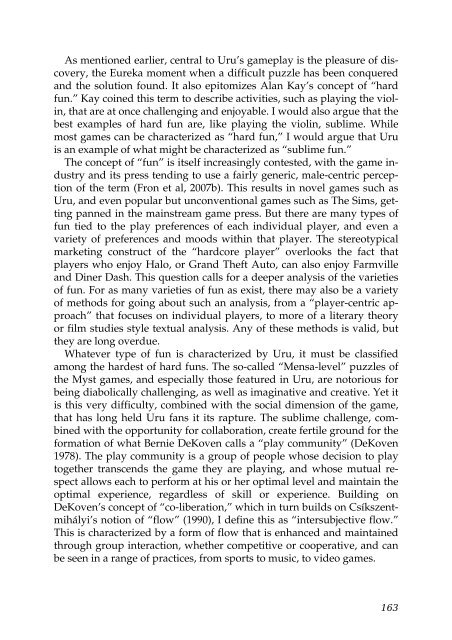Well Played 2.0: Video Games, Value and Meaning - OpenLibra
Well Played 2.0: Video Games, Value and Meaning - OpenLibra
Well Played 2.0: Video Games, Value and Meaning - OpenLibra
Create successful ePaper yourself
Turn your PDF publications into a flip-book with our unique Google optimized e-Paper software.
As mentioned earlier, central to Uru’s gameplay is the pleasure of discovery,<br />
the Eureka moment when a difficult puzzle has been conquered<br />
<strong>and</strong> the solution found. It also epitomizes Alan Kay’s concept of “hard<br />
fun.” Kay coined this term to describe activities, such as playing the violin,<br />
that are at once challenging <strong>and</strong> enjoyable. I would also argue that the<br />
best examples of hard fun are, like playing the violin, sublime. While<br />
most games can be characterized as “hard fun,” I would argue that Uru<br />
is an example of what might be characterized as “sublime fun.”<br />
The concept of “fun” is itself increasingly contested, with the game industry<br />
<strong>and</strong> its press tending to use a fairly generic, male-centric perception<br />
of the term (Fron et al, 2007b). This results in novel games such as<br />
Uru, <strong>and</strong> even popular but unconventional games such as The Sims, getting<br />
panned in the mainstream game press. But there are many types of<br />
fun tied to the play preferences of each individual player, <strong>and</strong> even a<br />
variety of preferences <strong>and</strong> moods within that player. The stereotypical<br />
marketing construct of the “hardcore player” overlooks the fact that<br />
players who enjoy Halo, or Gr<strong>and</strong> Theft Auto, can also enjoy Farmville<br />
<strong>and</strong> Diner Dash. This question calls for a deeper analysis of the varieties<br />
of fun. For as many varieties of fun as exist, there may also be a variety<br />
of methods for going about such an analysis, from a “player-centric approach”<br />
that focuses on individual players, to more of a literary theory<br />
or film studies style textual analysis. Any of these methods is valid, but<br />
they are long overdue.<br />
Whatever type of fun is characterized by Uru, it must be classified<br />
among the hardest of hard funs. The so-called “Mensa-level” puzzles of<br />
the Myst games, <strong>and</strong> especially those featured in Uru, are notorious for<br />
being diabolically challenging, as well as imaginative <strong>and</strong> creative. Yet it<br />
is this very difficulty, combined with the social dimension of the game,<br />
that has long held Uru fans it its rapture. The sublime challenge, combined<br />
with the opportunity for collaboration, create fertile ground for the<br />
formation of what Bernie DeKoven calls a “play community” (DeKoven<br />
1978). The play community is a group of people whose decision to play<br />
together transcends the game they are playing, <strong>and</strong> whose mutual respect<br />
allows each to perform at his or her optimal level <strong>and</strong> maintain the<br />
optimal experience, regardless of skill or experience. Building on<br />
DeKoven’s concept of “co-liberation,” which in turn builds on Csíkszentmihályi’s<br />
notion of “flow” (1990), I define this as “intersubjective flow.”<br />
This is characterized by a form of flow that is enhanced <strong>and</strong> maintained<br />
through group interaction, whether competitive or cooperative, <strong>and</strong> can<br />
be seen in a range of practices, from sports to music, to video games.<br />
163

















